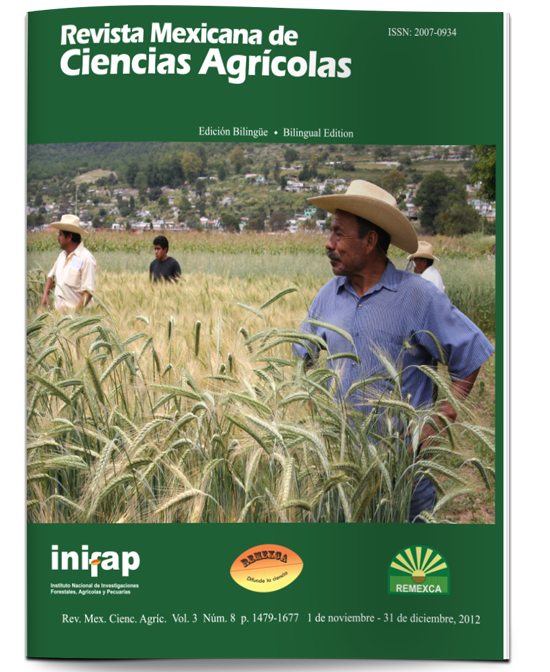Analysis of 20 genotypes of bread wheat in the Yaqui Valley, Sonora
DOI:
https://doi.org/10.29312/remexca.v3i8.1318Keywords:
Triticum aestivum L., grain yield, multivariate analysisAbstract
The work was conducted in the cycle autumn-winter 2008, under irrigated conditions in two sites in the Yaqui Valley, Sonora, Mexico, to assess 17 lines of bread wheat and three cultivars (control) for their grain yield, yield components and resistance to rust. The genetic material was evaluated in field in a randomized complete block with four replications per location. The variables recorded were: grain yield (GY), flowering (DF), physiological maturity (PM), plant height (PH) and incidences of lodging (IL) and leaf rust (LR). Data were subjected to analysis of variance individually and combined, comparison of treatment means with the Tukey test (α= 0.01) and to the main component analysis. Higher yielding lines were RSMF7CJ-62 (8.32 t ha-1 in block 609), and BABAX/ LR42 (7.53 t ha-1 in block 1605). If selection was made by grain yield the outstanding genotypes would be RSMF7CJ-92 (7.78 t ha-1), BABAX / LR42 (7.75 t ha-1) and RSMF7CJ -78 (7.74 t ha-1). The lines 01W20728 and Strong White are dwarfs, 05W90710, RSMF7CJ-90 and RSMF7CJ -92 are semi-dwarf and the remaining 13 and the three controls are tall. The genotypes were statistically equal in incidence of rust and the highest values were registered in Tacupeto (1.65%), 05W90685 (1.29%), Roelf (1.11%), 05W90710 (1.02%) and Kronstad (1.02%).
Downloads
Downloads
Published
How to Cite
Issue
Section
License
The authors who publish in Revista Mexicana de Ciencias Agrícolas accept the following conditions:
In accordance with copyright laws, Revista Mexicana de Ciencias Agrícolas recognizes and respects the authors’ moral right and ownership of property rights which will be transferred to the journal for dissemination in open access. Invariably, all the authors have to sign a letter of transfer of property rights and of originality of the article to Instituto Nacional de Investigaciones Forestales, Agrícolas y Pecuarias (INIFAP) [National Institute of Forestry, Agricultural and Livestock Research]. The author(s) must pay a fee for the reception of articles before proceeding to editorial review.
All the texts published by Revista Mexicana de Ciencias Agrícolas —with no exception— are distributed under a Creative Commons License Attribution-NonCommercial 4.0 International (CC BY-NC 4.0), which allows third parties to use the publication as long as the work’s authorship and its first publication in this journal are mentioned.
The author(s) can enter into independent and additional contractual agreements for the nonexclusive distribution of the version of the article published in Revista Mexicana de Ciencias Agrícolas (for example include it into an institutional repository or publish it in a book) as long as it is clearly and explicitly indicated that the work was published for the first time in Revista Mexicana de Ciencias Agrícolas.
For all the above, the authors shall send the Letter-transfer of Property Rights for the first publication duly filled in and signed by the author(s). This form must be sent as a PDF file to: revista_atm@yahoo.com.mx; cienciasagricola@inifap.gob.mx; remexca2017@gmail.
This work is licensed under a Creative Commons Attribution-Noncommercial 4.0 International license.



